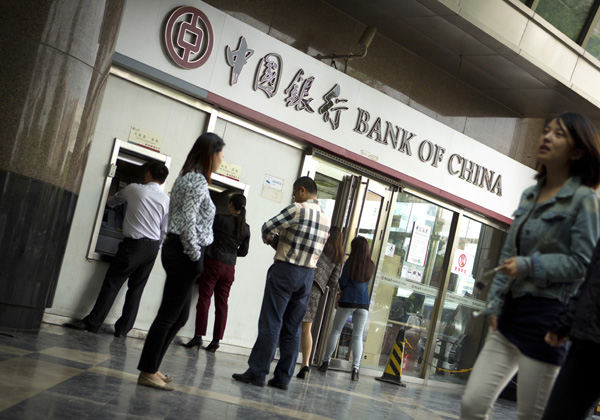|
 |
|
People walk past a Bank of China branch in Beijing as customers wait to use ATMs. Listed commercial banks are expected to accelerate the expansion of their credit asset securitization businesses this year. [Photo/Agencies] |
China's listed commercial banks are expected to accelerate the expansion of their credit asset securitization businesses in 2015, as regulators loosen their control over the sector and the banks themselves attempt to reduce risk amid the economic slowdown.
Those are the conclusions of a report released on Tuesday by Ernst & Young, which also revealed China last year issued 66 asset-backed securities worth a total of 281.98 billion yuan ($45 billion), compared with 101.8 billion yuan between 2005 and 2013.
Steven Xu, a partner with EY Financial Services, Greater China, said: "Credit asset securitization will be an important engine of growth for Chinese banks."
"It will liquidize banks' remnant assets to better meet the regulatory requirement on capital adequacy ratios and bring more intermediary business income," he said.
Of the 66 securities issued, 14 listed banks accounted for 25 of them, worth 132.19 billion yuan, or 47 percent of the total, the report said.
The People's Bank of China, the central bank, announced in early April that it will allow financial institutions that are qualified to carry out credit asset securitization business and that have already issued asset-backed securities, to apply for registration with the PBOC and issue ABS products before their registration expires.
Regulators, including the China Banking Regulatory Commission, also relaxed rules for the issuance of asset-backed securities last year.
"The Chinese regulators have not yet fully loosened their controls over credit asset securitization," said Geoffrey Choi, assurance leader at EY Financial Services in Greater China.
"When to further relax the regulations depends on when the risks associated with asset-backed securities can be controlled.
"China has allowed qualified banks to issue ABS products based on medium and long-term loans, which is different from the United States, where banks issued such products by combining bad assets into packages and used high leverage without adequate regulation, prior to the banking crisis which hit in 2008 and 2009."
How to prevent and control credit risk still remains one of the biggest challenges for listed banks.
Their non-performing loans have continued to grow annually since 2012.
Statistics from the CBRC showed that the average NPL ratio of commercial banks rose to 1.39 percent by the end of March, up 15 basis points from the previous quarter.
By Dec 31 last year, the outstanding special mention loans, potentially weak loans or assets presenting an unwarranted credit risk, of 21 listed banks had increased 43 percent from the end of 2013, amounting to 1.56 trillion yuan, according to the EY report.
